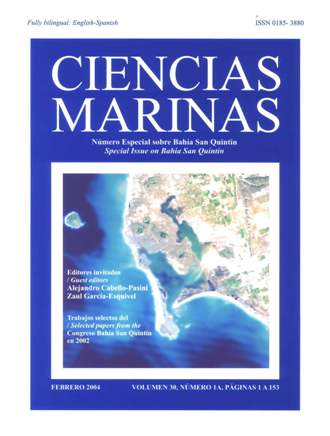Contribution of sedimentary resuspension to non-conservative fluxes of dissolved inorganic phosphorus in San Quintin Bay, Baja California: An experimental estimate
Main Article Content
Abstract
Abiotic processes like sedimentary resuspension may contribute to non-conservative fluxes of dissolved inorganic phosphorus (DIP) in shallow systems like San Quintín Bay (SQB), because suspended particles may adsorb or desorb inorganic phosphate. The contribution of suspended sediments to DIP concentrations in SQB was determined in the laboratory through adsorption-desorption experiments with two types of sediments (fine sand and sandy silt), and different concentrations of suspended particles, the initial concentration of DIP and resuspension time. The zero equilibrium phosphate concentration (EPC0) was observed during the first step of the adsorption process (fast step), which occurred before 10 h. The EPC0 was exceeded after 24 h of resuspension, indicating the diffusion of P from the surface toward the interior of particles (slow step). Adsorption was the dominant process in the experiments, and the intensity of adsorption-desorption was emphasized with an increase in the amount of resuspended particles. From the comparison of the non-conservative fluxes of DIP estimated using the LOICZ model with those estimated with resuspension experiments, we conclude that adsorption may lead to an underestimation of ~20% of net heterotrophy in SQB calculated with the LOICZ model, as excess respiration leads to a net release of DIP to the water column, but adsorption by particles masks this net release.
Downloads
Article Details
This is an open access article distributed under a Creative Commons Attribution 4.0 License, which allows you to share and adapt the work, as long as you give appropriate credit to the original author(s) and the source, provide a link to the Creative Commons license, and indicate if changes were made. Figures, tables and other elements in the article are included in the article’s CC BY 4.0 license, unless otherwise indicated. The journal title is protected by copyrights and not subject to this license. Full license deed can be viewed here.

